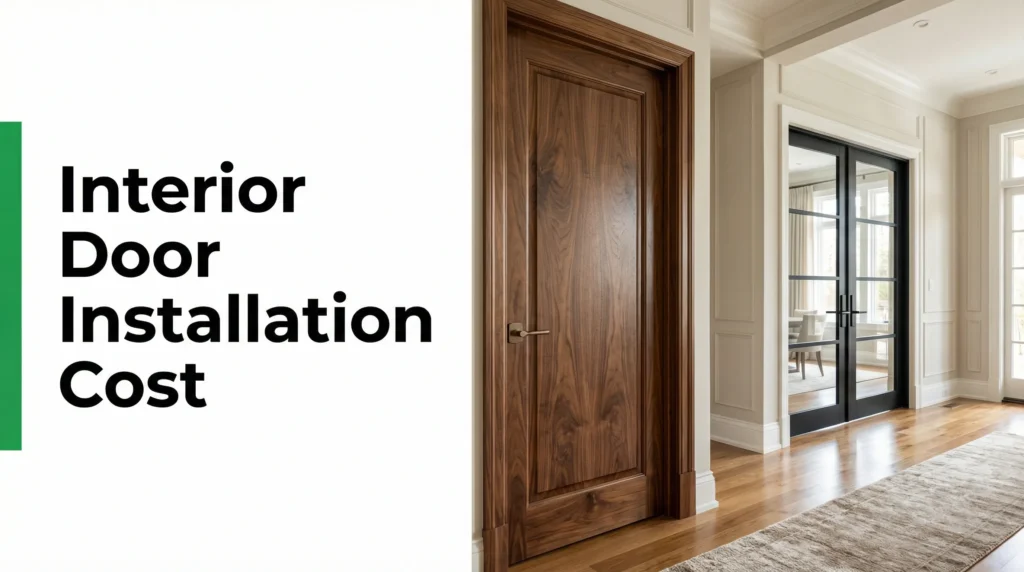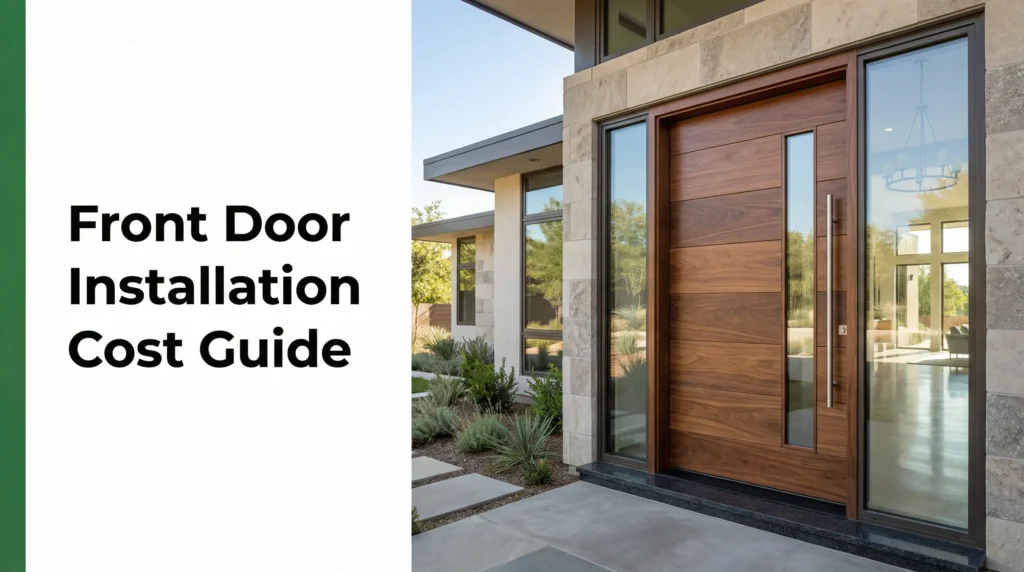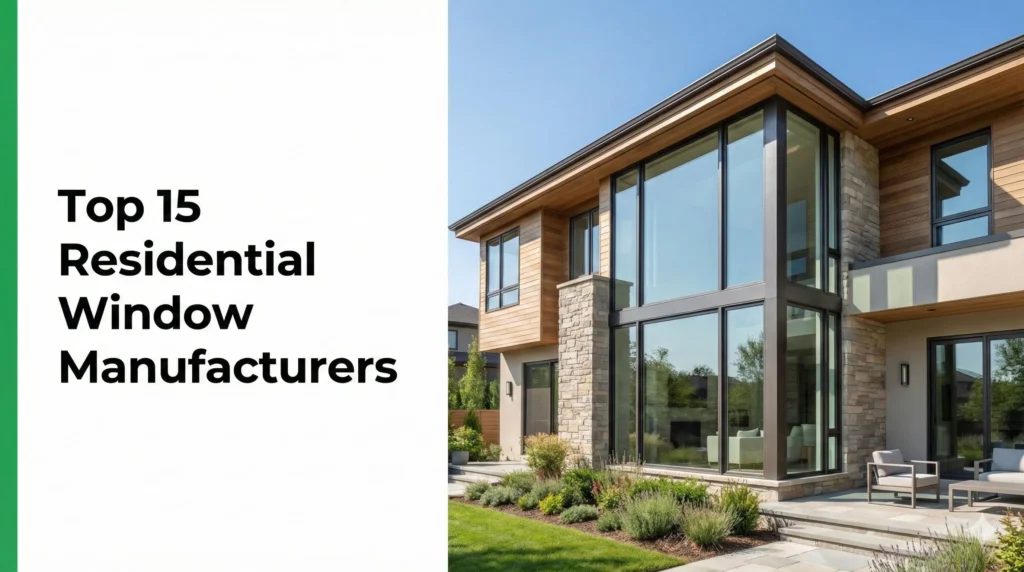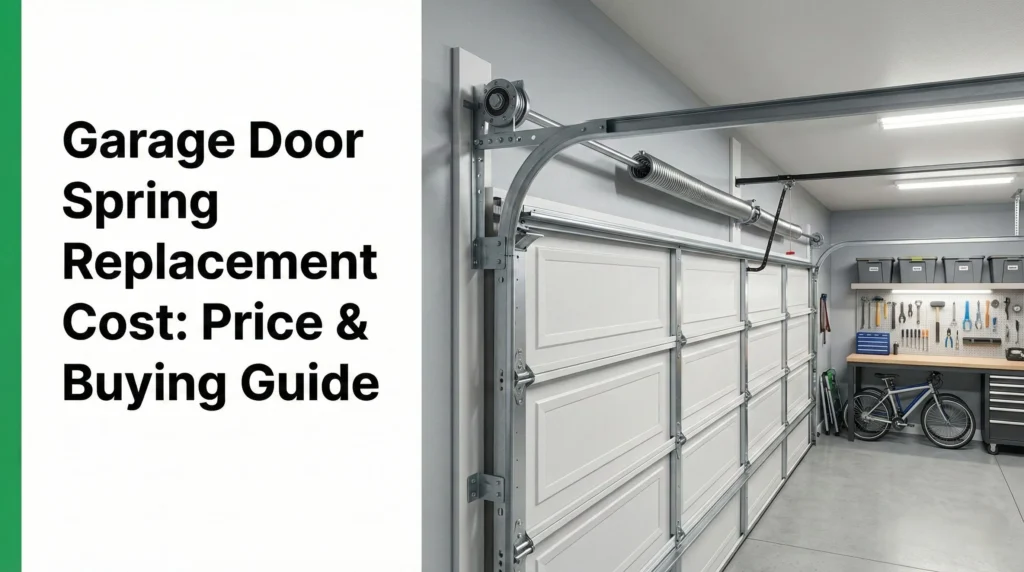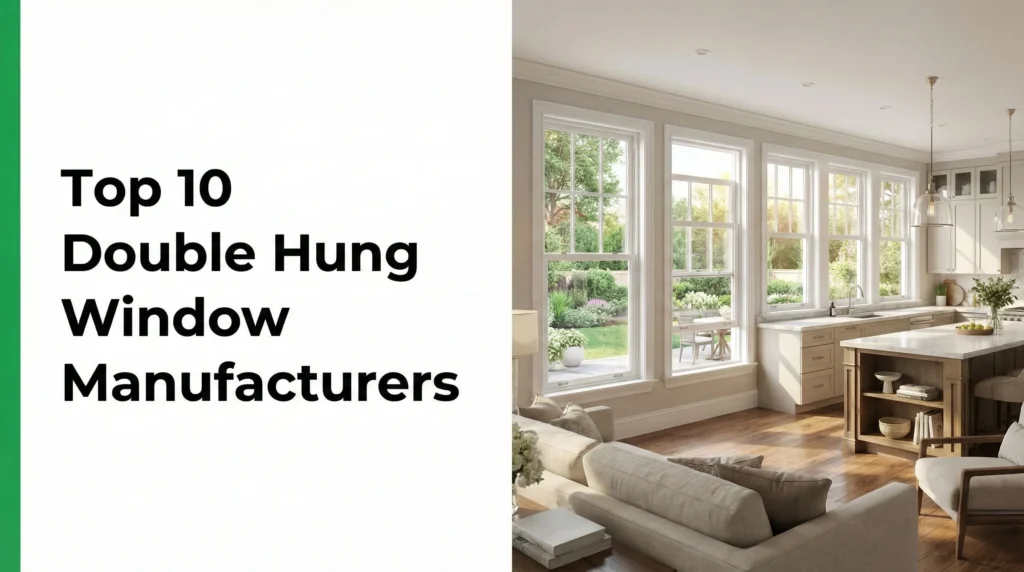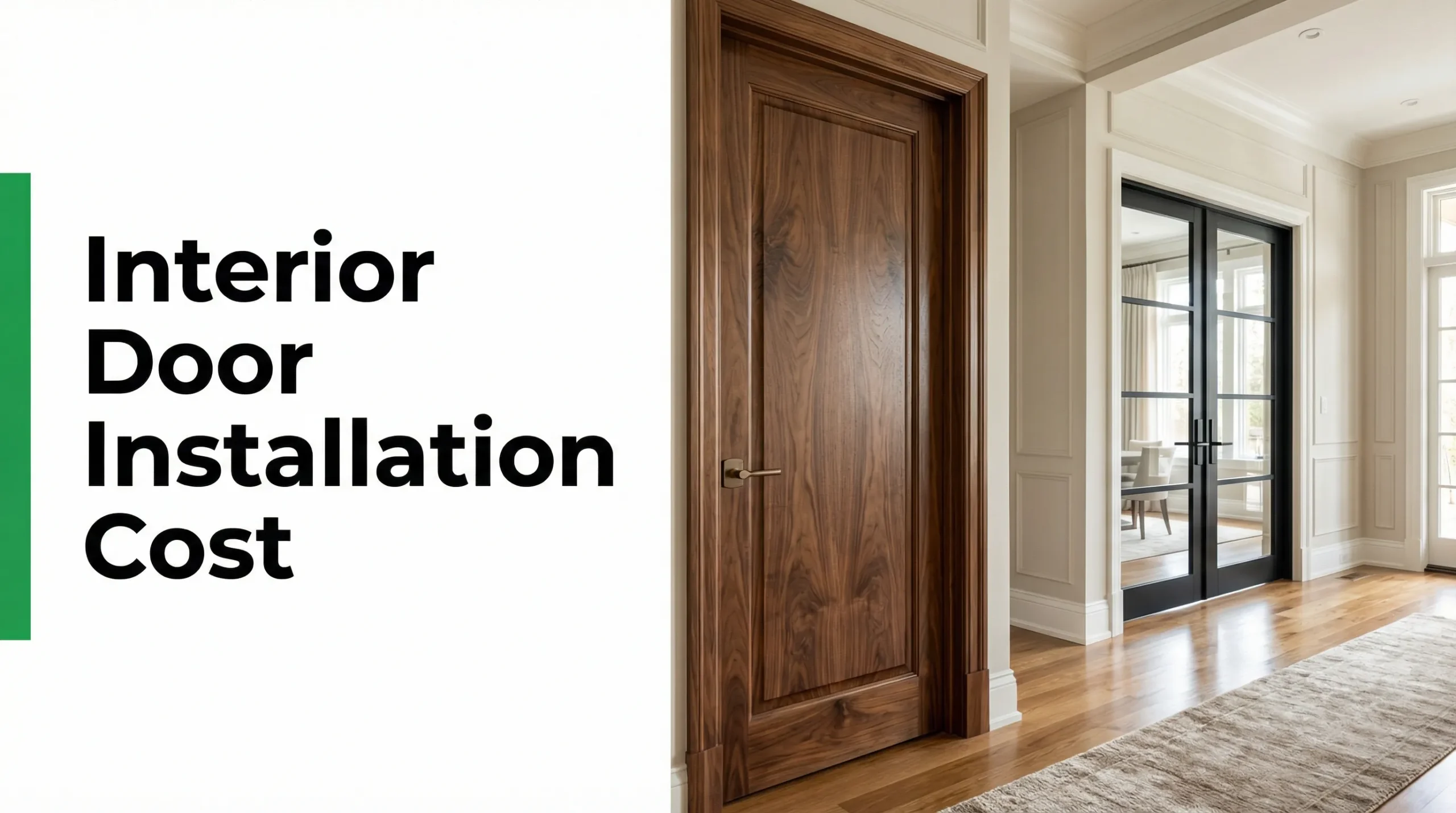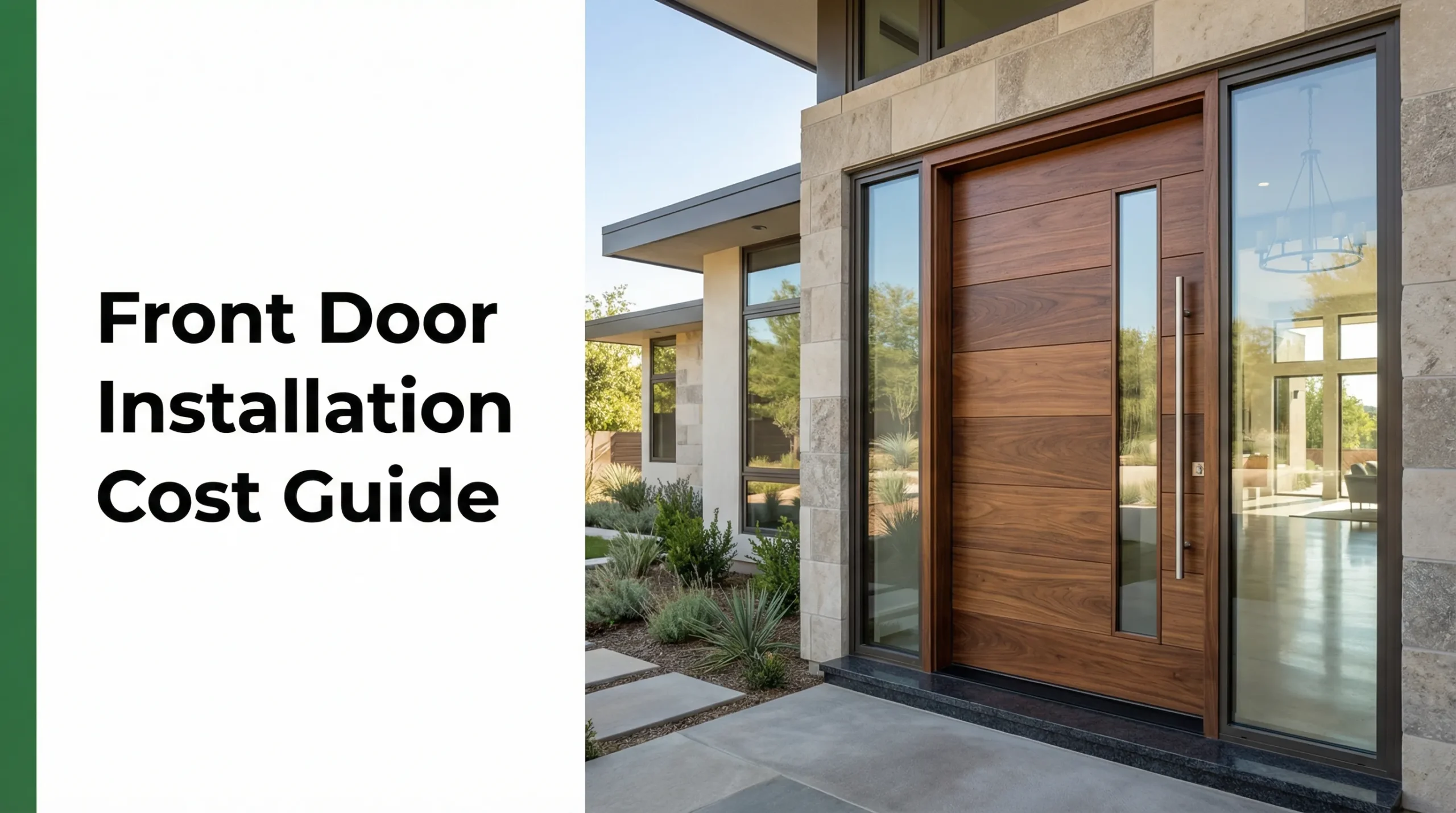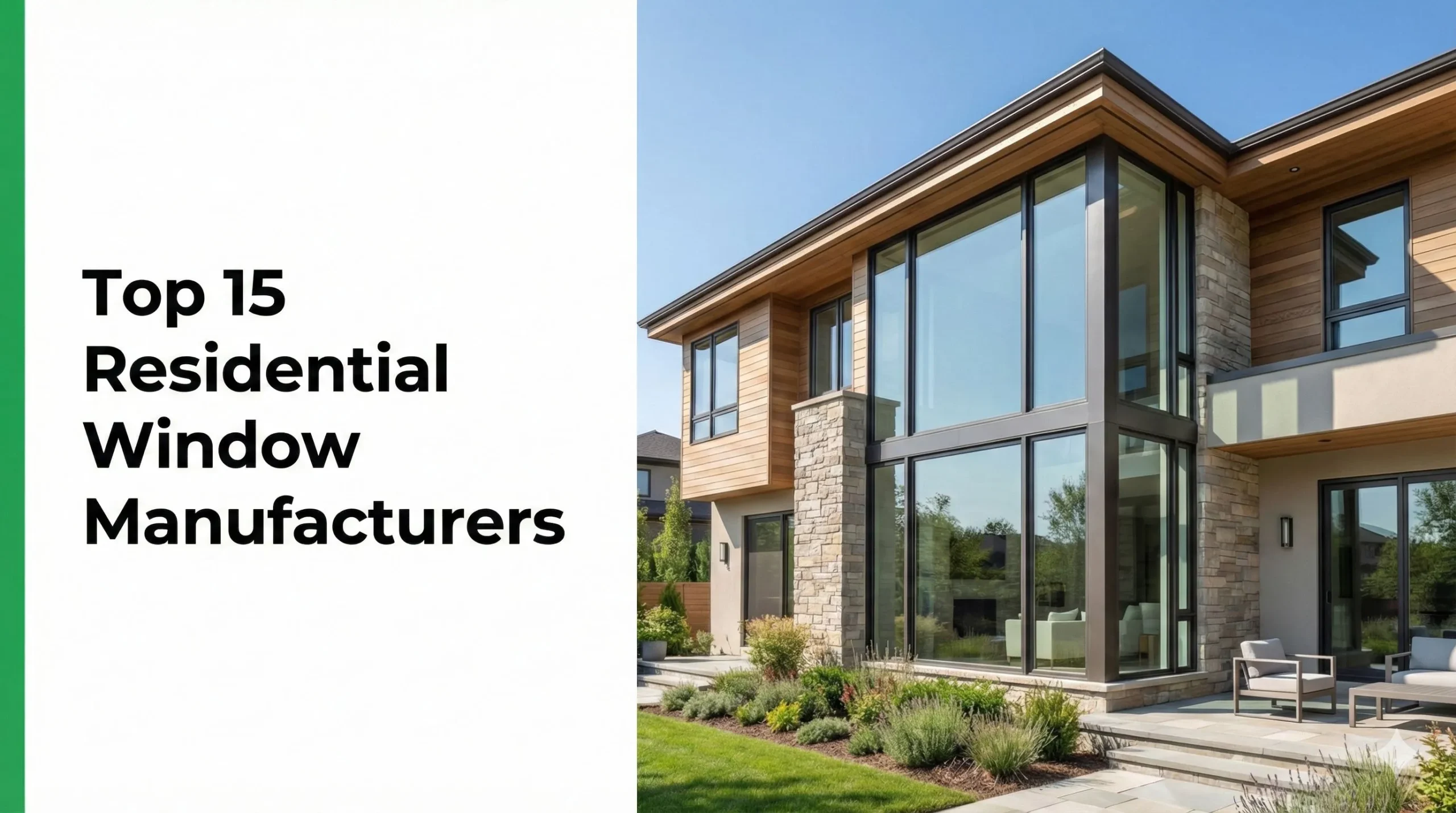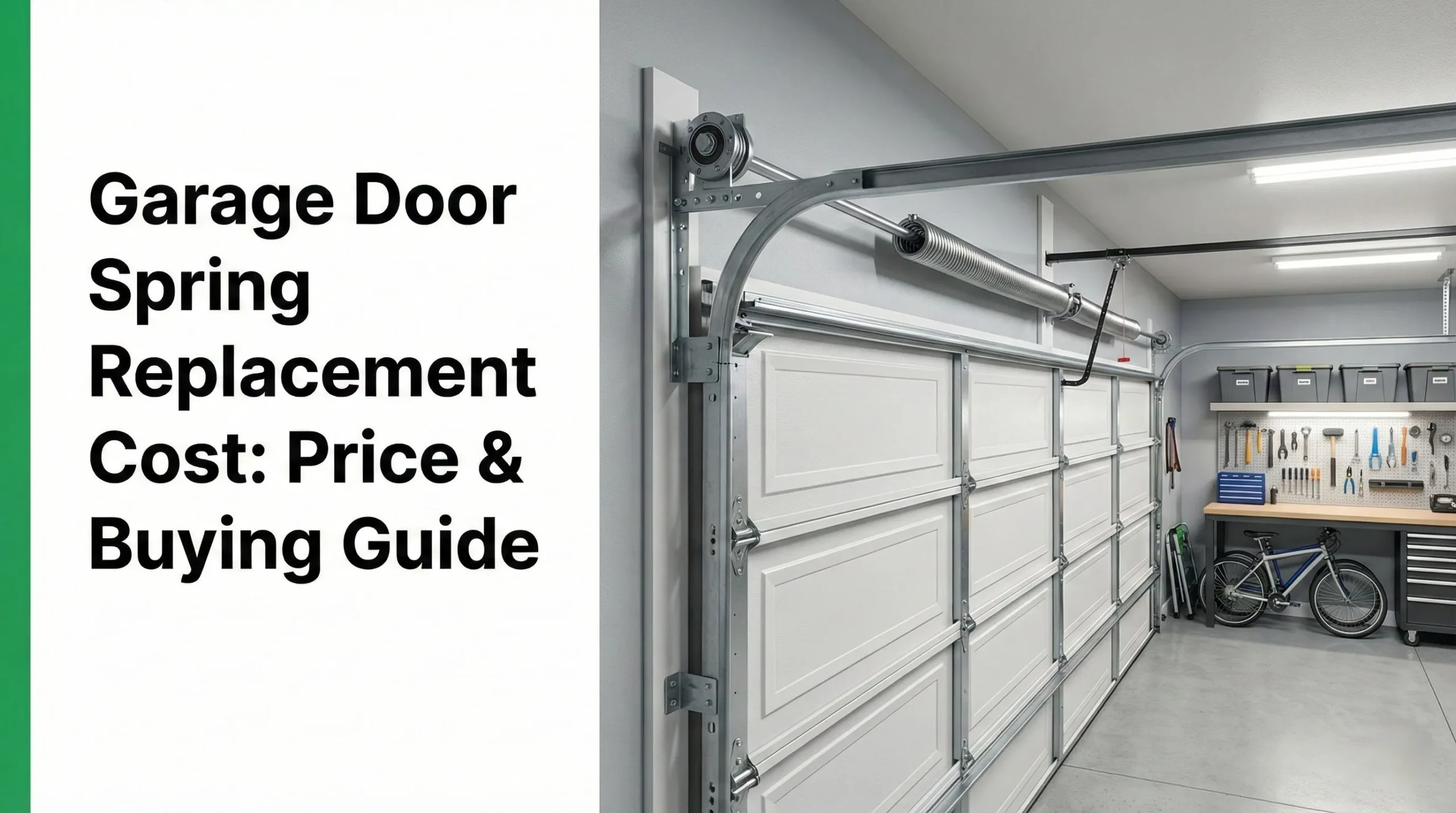¡Hola! ¿Estás pensando en cambiar tus puertas interiores o planear una renovación? ¡Genial! Elegir las puertas adecuadas puede parecer un detalle pequeño, pero créeme, marca la diferencia. enorme Diferencia. Elegir el tamaño correcto afecta la facilidad con la que te mueves por tu casa, el aspecto y la sensación de tus habitaciones, e incluso la cantidad de... costos del proyecto.
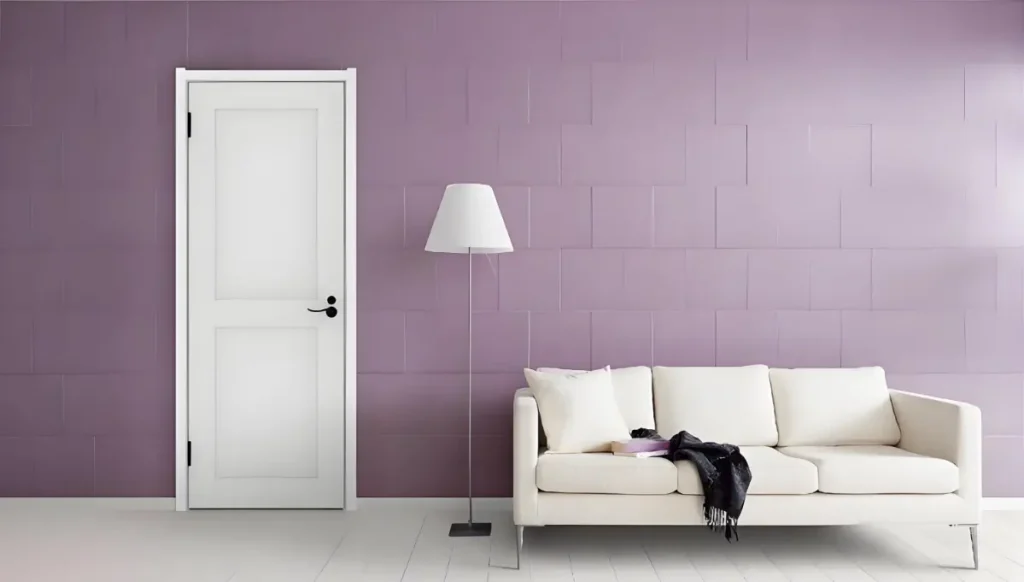
¿Alguna vez has entrado en una habitación y has sentido que la puerta era demasiado estrecha? ¿O tal vez has visto una puerta que parecía extrañamente alta o baja para el espacio? ¡Estos pequeños detalles pueden arruinar la atmósfera! Muchos propietarios cometen errores de tamaño, lo que resulta en costos adicionales, problemas de instalación frustrantes o puertas que simplemente no funcionan bien.
¡Pero no te preocupes! Esta guía te será de gran ayuda. Te explicaremos paso a paso todo lo que necesitas saber sobre los tamaños estándar de puertas interiores. Desglosaremos la jerga, exploraremos los diferentes tipos y te daremos consejos prácticos para medir y elegir las puertas perfectas. su Inicio. ¿Listo para convertirte en un experto en dimensionar puertas? ¡Comencemos!
A veces, simplemente necesitas las cifras rápidamente. Aquí tienes un breve resumen de los tamaños de puertas interiores estándar más comunes que encontrarás en EE. UU.:
Tabla de referencia rápida: tamaños estándar comunes de puertas interiores
| Característica | Estándar estadounidense/imperial | Equivalente métrico (aprox.) | Notas |
|---|---|---|---|
| Altura | 80 pulgadas (6′ 8″) | 2032 milímetros | El estándar más común con diferencia. |
| 84 pulgadas (7′ 0″) | 2134 milímetros | Cada vez más popular en los hogares modernos. | |
| 96 pulgadas (8′ 0″) | 2438 milímetros | Se utiliza a menudo para techos altos y sensación de lujo. | |
| Ancho | 24 pulgadas | 610 milímetros | Armarios, pequeños espacios de servicio. |
| 28 pulgadas | 711 milímetros | Baños, a veces dormitorios pequeños. | |
| 30 pulgadas | 762 milímetros | Dormitorios, puertas de paso comunes. | |
| 32 pulgadas | 813 milímetros | Pasaje común, cumple accesibilidad básica. | |
| 34 pulgadas | 864 milímetros | Puertas de paso más anchas. | |
| 36 pulgadas | 914 milímetros | Puertas de paso principales, entrada a menudo requerida. | |
| Espesor | 1 ⅜ pulgadas | 35 milímetros | Estándar para la mayoría de puertas interiores. |
| 1 ¾ pulgadas | 44 milímetros | Para trabajo pesado, exterior, algunos núcleos sólidos. |
Recordar: ¡Esto es solo un breve resumen! A continuación, exploraremos estas dimensiones (¡y más!) con mucho más detalle.
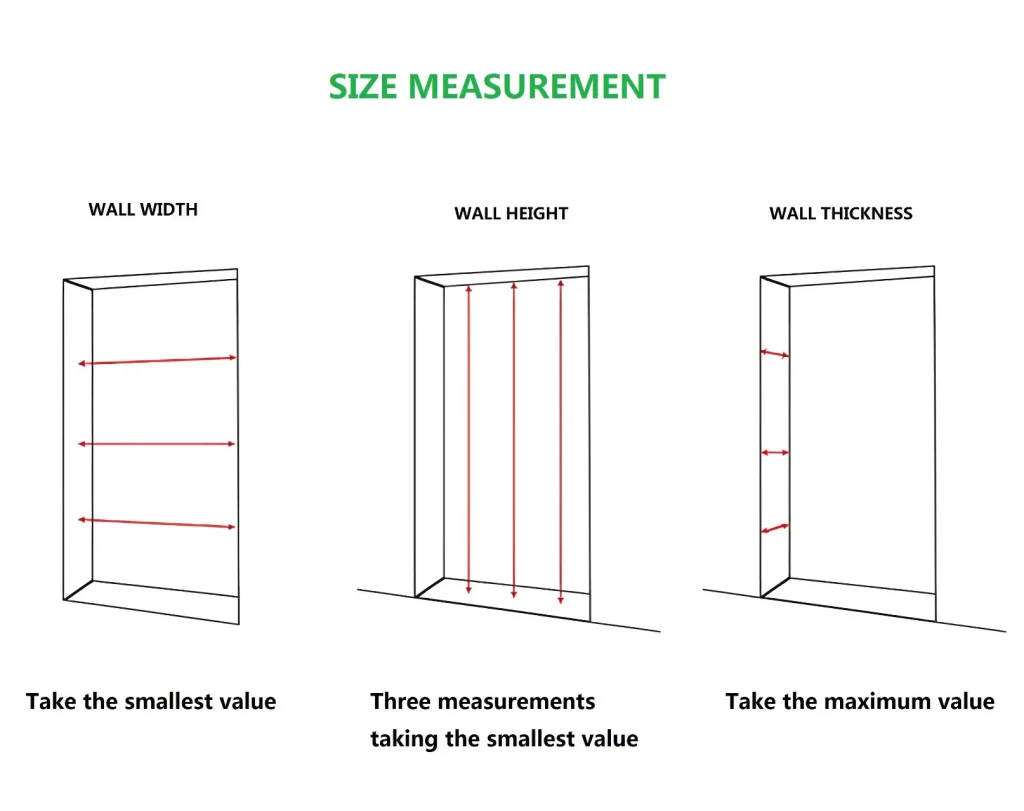
Antes de profundizar, aclaremos algunos términos comunes que escuchará al trabajar con puertas. Conocerlos facilitará mucho la compra y la instalación.
- Dimensiones nominales vs. reales: ¡Esto a veces confunde a la gente! El tamaño "nominal" es el nombre o tamaño estándar que le damos a la puerta (como "puerta de 76 cm"). El tamaño "real" es la medida exacta de la losa de la puerta, que suele ser ligeramente más pequeña (quizás entre 3 mm y 12 mm menos en ancho y alto) para dejar espacio y encajar correctamente en el marco. Piénselo como una pieza de madera de 5 x 10 cm: su nombre nominal no es su... actual Tamaño medido (que se acerca más a 1,5″ x 3,5″). ¡Confirma siempre si estás viendo tamaños nominales o reales!
- Notación de la industria: Es posible que vea tamaños escritos como "2/6 x 6/8". ¡Esto es una abreviatura! El primer número corresponde a pies/pulgadas de ancho (2/6 = 2 pies, 6 pulgadas = 30 pulgadas). El segundo corresponde a pies/pulgadas de alto (6/8 = 6 pies, 8 pulgadas = 80 pulgadas). Por lo tanto, 2/6 x 6/8 significa una puerta de 30″ x 80″.
- Componentes clave:
- Losa de la puerta: Esta es solo la puerta en sí, sin marco, bisagras ni herrajes.
- Ancho/profundidad de la jamba: La jamba es el marco que rodea la hoja de la puerta. ancho debe coincidir con el grosor de su pared (incluido el panel de yeso). profundidad se refiere al espesor del material de la jamba en sí.
- Detener: Esta es la delgada tira de madera dentro del marco de la puerta, contra la que esta se apoya al cerrarse. Su ubicación es crucial para un ajuste perfecto.
- Especificaciones del marco: Esto se refiere a la unidad completa ensamblada alrededor de la puerta, incluidas las jambas (piezas laterales y cabezal) y posiblemente el umbral o alféizar (aunque es menos común para puertas interiores).
- Espesor estándar: Como se ve en la tabla, el espesor más común para puertas interiores es 1 ⅜ pulgadas (35 mm)Esto funciona tanto para puertas de núcleo hueco (más ligeras y económicas) como para muchas puertas de núcleo macizo (más pesadas y con mejor aislamiento acústico). Es posible que encuentre... 1 ¾ pulgadas (44 mm) espesor para aplicaciones más pesadas, algunas puertas resistentes al fuego o, a veces, como estándar en puertas de entrada.
Bien, analicemos esos tamaños estándar con más detalle.
Alturas estándar de puertas interiores: alcanzando nuevos niveles
altura estándar de la puerta interior
- 80 pulgadas (6 pies 8 pulgadas o 6/8): ¡Esta es la mejor! Durante décadas, 80 pulgadas ha sido la altura estándar para puertas interiores en Estados Unidos. Se adapta bien a techos de 8 pies de altura, es fácil de conseguir y asequible. Si va a reemplazar las puertas de una casa típica construida en los últimos 50-60 años, es muy probable que tengan 80 pulgadas de altura.
- 84 pulgadas (7 pies o 7/0): ¡Están en auge! Dado que las casas nuevas suelen tener techos más altos (de 2,7 metros o más), las puertas de 2,1 metros son cada vez más comunes. Pueden hacer que una habitación parezca más alta y espaciosa.
- 96 pulgadas (8 pies u 8/0): ¡Hola, lujo! Para casas con techos muy altos (3 metros o más), las puertas de 2,4 metros crean un ambiente impactante. Lucen imponentes y modernas, pero son más caras y requieren una estructura específica.
- Variaciones y códigos regionales: Aunque 80″ es la norma, ¡siempre consulte los códigos de construcción locales! A veces, pueden requerirse alturas mínimas específicas, especialmente para accesibilidad. Las casas antiguas, sobre todo las de antes de la Segunda Guerra Mundial, pueden tener alturas únicas y no estándar. ¡Hablaremos de esto más adelante!
Anchos de puertas interiores estándar: cómo encontrar el ajuste perfecto
El ancho es crucial para moverse con comodidad entre habitaciones. A continuación, se detallan los anchos más comunes y dónde se suelen encontrar:
Anchos de puerta de paso comunes
- Anchos de puerta de paso comunes:
- 24 pulgadas (2/0): Generalmente reservado para armarios, tocadores pequeños o armarios para ropa blanca. Puede resultar bastante estrecho para el paso habitual. Considere si... tamaño de la puerta de la despensa Necesita acomodar artículos más grandes.
- 28 pulgadas (2/4): Se usa a menudo en baños o dormitorios pequeños con poco espacio. Es aceptable, pero puede ser complicado mover muebles.
- 30 pulgadas (2/6): Un ancho muy común para dormitorios y otras habitaciones. Ofrece un paso cómodo para la mayoría de las personas.
- 32 pulgadas (2/8): Otra opción popular, especialmente para pasillos principales. Cabe destacar que este ancho (al combinarse con bisagras estándar) suele proporcionar la abertura mínima requerida por las normas de accesibilidad de la ADA (¡más información al respecto más adelante!).
- 34 pulgadas (2/10): Menos común que el de 32″ o 36″, pero ofrece una sensación ligeramente más amplia y generosa.
- 36 pulgadas (3/0): Se utiliza a menudo en pasillos principales, entradas desde garajes o cualquier lugar donde se necesite mover muebles grandes o se desee una sensación de mayor amplitud. Generalmente, se considera un ancho muy cómodo.
- Reflexiones específicas sobre la habitación: Piensa en cómo usas la habitación. Un dormitorio necesita que los muebles quepan. Un pasillo principal tiene mucho tráfico. Un pequeño armario para ropa blanca podría necesitar solo una puerta de 60 cm. ¡Planificar con antelación te ahorra dolores de cabeza!
- Mínimos del código de construcción: Los códigos suelen especificar anchos mínimos, especialmente para salidas y accesibilidad. Por ejemplo, al menos una puerta de entrada principal a una vivienda suele tener 91 cm de ancho. ¡Consulte siempre los requisitos locales! Considerando la amplia gama de... Tamaños de puertas estándar Ayuda a garantizar el cumplimiento y la funcionalidad.
Grosor estándar de puerta interior: hueca o sólida
Espesor estándar de puerta interior
Hemos tocado este tema, pero volvamos rápidamente a lo siguiente:
- 1 ⅜ pulgadas (35 mm): El estándar de referencia para la mayoría de las aplicaciones interiores. Es compatible con herrajes y jambas estándar. Encontrará ambos:
- Puertas de núcleo hueco: Más ligeros, económicos, fabricados con una estructura interna de panal o con un marco minimalista recubierto con una lámina (chapa de madera, MDF, etc.). Ofrecen un aislamiento acústico mínimo.
- Puertas de núcleo macizo: Más pesados, más densos, a menudo rellenos de aglomerado o madera contrachapada. Ofrecen una amortiguación acústica mucho mejor y se sienten más sólidos. Suelen tener un grosor de 3,8 cm.
- 1 ¾ pulgadas (44 mm): Menos común dentro del hogar pero se utiliza para:
- Puertas que necesitan mayor durabilidad o seguridad (como quizás una puerta de taller).
- Algunas puertas cortafuegos.
- Se utiliza ocasionalmente para puertas de madera maciza de alta gama y muy pesadas.
- A menudo, el grosor estándar para puertas exteriores, como la suya tamaño de puerta de entrada estándar.
Adaptación de las paredes: estándares de ancho de las jambas de las puertas
La jamba de la puerta debe encajar perfectamente alrededor del grosor de la pared.
- 4 ⅝ pulgadas (a veces se indica como 4 9/16″): Este es el ancho de jamba estándar para paredes construidas con montantes de 2×4 más paneles de yeso estándar de ½ pulgada en cada Lateral (montante de 8,9 cm + panel de yeso de 1,25 cm + panel de yeso de 1,25 cm ≈ 11,4 cm, con un pequeño margen de maniobra). Esta es la construcción de paredes interiores más común en EE. UU.
- 6 ⅝ pulgadas (a veces aparece como 6 9/16″): Esto se utiliza para paredes construidas con 2×6 pernos Más paneles de yeso estándar. Estas paredes más gruesas se suelen usar para paredes exteriores o, a veces, para paredes interiores que contienen tuberías.
- Opciones personalizadas: Si tiene espesores de pared no estándar (como paredes de yeso en casas antiguas o paredes con capas adicionales), es posible que necesite anchos de jamba personalizados o extensiones de jamba.
Tipos de puertas interiores y sus tamaños
Las puertas interiores no son simples paneles con bisagras. Cada tipo satisface distintas necesidades y vienen en tamaños estándar.
- Puertas de paso con bisagras: La clásica puerta batiente.
- Soltero: El tipo más común, disponible en todos los anchos y alturas estándar mencionados anteriormente.
- Doble (puertas francesas): Dos puertas que se unen en el centro. Se suelen usar para aberturas más amplias en comedores, oficinas o suites principales. Las combinaciones comunes son dos puertas de 61 cm, 76 cm o 81 cm para llenar una abertura de 1,22 m, 1,52 m o 1,83 m. Explore varias opciones. Tabla de medidas y tamaños de puertas francesas Opciones. Para inauguraciones más grandes, considere las posibilidades de puerta francesa de mayor tamaño Combinaciones. Incluso pueden salir al exterior, superponiéndose con tamaño estándar de puerta de patio conceptos.
- Puertas de bolsillo: Estas diapositivas en La pared, ahorrando espacio. Ideal para baños o armarios donde una puerta batiente resultaría incómoda. Utilizan tamaños de puerta estándar (p. ej., 76 x 203 cm), pero requieren una cavidad en la pared de aproximadamente el doble del ancho de la puerta para alojar el riel y la puerta cuando está abierta. La instalación es más compleja que la de una puerta batiente estándar.
- Puertas plegables: Se usa frecuentemente en armarios o lavanderías. Dos o más paneles se unen con bisagras y se pliegan al abrirse.
- Los anchos comunes incluyen 24″, 30″, 36″, 48″, 60″ y 72″. Cada ancho suele constar de dos o cuatro paneles. Consulte los tamaños específicos. tamaño de la puerta plegable opciones. ¡Son excelentes ahorradores de espacio!
- Puertas corredizas: Estos se deslizan a lo largo de una pista paralela a la pared.
- Puertas de granero: Las puertas de granero, modernas y rústicas (¡o modernas!), cuelgan de un riel expuesto sobre la abertura. Necesitan espacio libre en la pared junto a la abertura para que la puerta se deslice. Se utilizan tamaños de puerta estándar, pero asegúrese de que la puerta sea ligeramente más ancha y alta que la abertura para cubrirla por completo. Ver ejemplos típicos. tamaño de la puerta del granero Consideraciones.
- Puertas de derivación: Dos o más puertas se deslizan sobre rieles paralelos, generalmente utilizados en armarios anchos. Una puerta se desliza delante de la otra. En este caso, suelen aplicarse los anchos estándar de las puertas de armario. El concepto es similar al de algunos... Tamaños de puertas corredizas con mosquitera configuraciones, solo se usan internamente.
- Puertas corredizas generales: Similares a las puertas de patio, pero para uso interior, quizás para separar habitaciones grandes. Considere los espacios libres necesarios. A veces, estos se superponen con... tamaño estándar de puerta corrediza de vidrio diseños pero utilizan paneles sólidos.
- Puertas plegables: Similar a la plegable, pero a menudo con más paneles, lo que permite cerrar aberturas muy amplias, como separar la sala de estar del comedor. Descubre varias opciones. tamaños de puertas plegables para estas aplicaciones.
Enmarcarlo correctamente: Dimensiones aproximadas de la abertura
¡Esto es fundamental para la instalación! La abertura sin terminar es el orificio enmarcado en la pared. antes La puerta y la jamba están instaladas. Debe ser más grande que la unidad de la puerta para dejar espacio para las jambas, calzar (insertar pequeñas cuñas para que el marco quede perfectamente aplomado y nivelado) y escuadrar.
- Cálculo de aberturas aproximadas (la regla simple):
- Ancho de la abertura aproximada = Ancho de la losa de la puerta + 2 pulgadas (Permite el espesor de la jamba en ambos lados + espacio para calzas).
- Altura de la abertura aproximada = Altura de la losa de la puerta + 2 a 2,5 pulgadas (Tiene en cuenta el espesor del marco superior, el espacio entre calzas y el espacio libre del piso). ¡Siempre verifique dos veces las recomendaciones del fabricante, ya que pueden variar levemente!
- Tabla de tamaños de aberturas en bruto (ejemplos comunes): Tamaño nominal de la puerta (An. x Al.) Abertura típica en bruto (An. x Al.) 24″ x 80″ 26″ x 82″ – 82.5″ 28″ x 80″ 30″ x 82″ – 82.5″ 30″ x 80″ 32″ x 82″ – 82.5″ 32″ x 80″ 34″ x 82″ – 82.5″ 36″ x 80″ 38″ x 82″ – 82.5″ 30″ x 84″ 32″ x 86″ – 86.5″ 36″ x 96″ 38″ x 98″ – 98.5″
- Especificaciones de enmarcado y encabezados: Sobre la abertura de la puerta, se necesita un dintel. Se trata de una viga estructural horizontal que soporta el peso de la pared superior (montantes, etc.) sobre la abertura.
- Muros de carga: Si la pared soporta el peso del techo o del piso superior, el dintel debe tener el tamaño adecuado según el código para soportar esa carga (a menudo está hecho de madera duplicada o vigas diseñadas).
- Muros no portantes: Si la pared solo separa habitaciones, el requisito del dintel es mucho más sencillo (a menudo, basta con un listón plano de 2x4). ¡Un error en este punto puede causar problemas estructurales!
Abriendo puertas para todos: Accesibilidad y diseño universal
Hacer que las viviendas sean habitables para personas de todas las edades y capacidades es cada vez más importante. ¡Las dimensiones de las puertas son clave!
- Requisitos de la ADA (Ley de Estadounidenses con Discapacidades): Aunque se centran principalmente en espacios públicos, las directrices de la ADA suelen adoptarse o consultarse para viviendas accesibles. El requisito clave es un mínimo Ancho libre de 32 pulgadas Cuando la puerta está abierta a 90 grados. ¡Este no es el ancho de la losa de la puerta! Una puerta de 91 cm suele proporcionar esto, mientras que una de 86 cm podría... justo Cumplir con ello dependiendo del tipo de bisagra y la ubicación del tope. Una puerta de 32 pulgadas normalmente... no Proporciona 32 pulgadas de paso libre.
- Autorizaciones de maniobra: La ADA también especifica el espacio libre en el piso necesario alrededor la puerta (tanto del lado de empuje como del de tracción) para permitir que los usuarios de sillas de ruedas se acerquen y abran la puerta.
- Hardware: Se prefieren las manijas de palanca a las perillas redondas porque son más fáciles de operar sin necesidad de agarrar con fuerza ni girar.
- Diseño universal: Este concepto más amplio busca crear hogares que funcionen para todos, sin importar la edad o las capacidades. Esto incluye puertas más anchas (se recomiendan 91 cm), manijas de palanca y la consideración de umbrales y transiciones entre habitaciones. Se trata de asegurar su hogar para el futuro, para usted, para las visitas de familiares o para aumentar su valor de reventa.
Puertas en todo el mundo: estándares internacionales de tamaño
Si bien nos hemos centrado en EE. UU., ¡los tamaños de las puertas varían a nivel mundial!
- América del Norte vs. Europa: En Estados Unidos y Canadá, se utilizan principalmente medidas imperiales (pulgadas, pies) y los estándares que hemos mencionado (80″ de altura). Europa utiliza principalmente el sistema métrico decimal (milímetros, metros).
- Tallas europeas comunes: Las alturas estándar suelen oscilar entre 1950 mm y 2150 mm. Los anchos suelen ser de 600 mm, 700 mm, 800 mm y 900 mm. El grosor de las puertas puede rondar los 40 mm.
- Tallas del Reino Unido: El Reino Unido combina la historia imperial con la adopción del sistema métrico decimal. Se pueden encontrar medidas de hasta 1981 mm (aprox. 1,98 m) y 762 mm (aprox. 76 cm).
- Otras regiones (Asia, Australia, Oriente Medio): Los estándares varían considerablemente según las prácticas de construcción locales, la historia y la influencia del sistema métrico/imperial. En Australia, por ejemplo, se suelen utilizar alturas de 2040 mm y anchos de 820 mm.
- Conversión métrica: Recuerda: 1 pulgada equivale a 25,4 milímetros. Una tabla de conversión rápida te ayudará a comparar.
La historia de los tamaños de las puertas
¿Alguna vez se preguntó por qué nuestras puertas tienen los tamaños que tienen?
- Antes y después de la guerra: Las casas antiguas (anteriores a la década de 1940) suelen presentar mucha más variedad. Se pueden encontrar puertas más cortas y estrechas, o a veces sorprendentemente altas, lo que refleja diferentes métodos de construcción y estilos arquitectónicos. El auge de la construcción de la posguerra condujo a una mayor estandarización para la producción en masa, consolidando alturas como las de 80 pulgadas.
- Cambiar la altura humana: A medida que la altura promedio de los seres humanos ha aumentado a lo largo de los siglos, la altura de las puertas en general ha seguido el mismo camino, aunque a menudo se ha quedado atrás.
- Estilos regionales: Los distintos movimientos arquitectónicos enfatizaron proporciones distintas. Un bungalow de estilo artesano podría tener una estética de puerta distinta a la de un rancho de mediados de siglo.
Tendencias en tamaños de puertas modernas
¡El diseño del hogar está en constante evolución!
- Taller está en: Como se mencionó, las puertas de 2,13 m (84″) y 2,44 m (96″) son cada vez más populares, especialmente en techos altos. Crean una sensación de amplitud y lujo.
- Pasajes más amplios: Hay una tendencia hacia puertas más anchas (32″ o 36″) incluso para habitaciones estándar, lo que mejora el flujo y la accesibilidad.
- Minimalista y de altura completa: Los diseños elegantes y minimalistas son populares. Esto incluye puertas de altura completa que llegan casi del suelo al techo, a menudo con bisagras y marcos ocultos para una apariencia uniforme.
- Diseños al ras: Las puertas simples y de superficies planas (puertas al ras) siguen siendo populares para los estilos modernos y contemporáneos.
Cómo medir correctamente las puertas interiores
¡La precisión en las mediciones es FUNDAMENTAL! ¡No adivines! Aquí te explicamos cómo hacerlo bien:
Guía paso a paso:
- Mida la losa de la puerta existente (si la va a reemplazar):
- Ancho: Medir la actual Ancho de la hoja de la puerta en tres puntos: superior, central e inferior. Use la medida MÁS ANCHA.
- Altura: Medir la actual Altura tanto en el lado izquierdo como en el derecho. Use la medida MÁS ALTA.
- Espesor: Mida el borde de la puerta para obtener su grosor (generalmente 1 ⅜” o 1 ¾”).
- Mida la abertura de la puerta (si no hay puerta o para unidades precolgadas):
- Ancho (de jamba a jamba interior): Mida la distancia entre las jambas laterales superior, central e inferior. Use la medida más angosta.
- Altura (desde el cabecero hasta el suelo): Mida desde la parte inferior de la jamba de la cabeza hasta la piso terminado (incluyendo alfombras, azulejos, etc.). Mida tanto en el lado izquierdo como en el derecho. Use la medida MÁS CORTA.
- Espesor de la pared (ancho de la jamba): Mida el grosor total de la pared (montante + panel de yeso en ambos lados). Esto determinará el ancho de la jamba que necesita (por ejemplo, 11,5 cm para una pared de 5x10 cm).
- Comprobar cuadrado: Utilice un nivel para asegurar que el marco existente esté a plomo (verticalmente) y el dintel (horizontalmente). Use una cinta métrica para comprobar las medidas diagonales de la abertura: si son iguales, la abertura está a escuadra. De lo contrario, podría ser necesario realizar ajustes durante la instalación.
Errores comunes a evitar:
- ❌ Medición de la recortar (carcasa) alrededor de la puerta, no la puerta o la abertura en sí.
- ❌ Olvidar contabilizar el piso terminado Altura. Medir la superficie real sobre la que girará la puerta.
- ❌ ¡Solo mide una vez! ¡Siempre mide el ancho y la altura en varios puntos!
- ❌ Suponer que una abertura está cuadrada o a plomo sin comprobarlo.
- ❌ Sin tener en cuenta el espacio libre para abrirse, asegúrese de que la puerta tenga espacio para abrirse completamente sin golpear muebles ni paredes.
Más allá de lo básico: aplicaciones especializadas para puertas interiores
A veces es necesario que una puerta haga más que simplemente abrirse y cerrarse.
- Insonorización: ¿Quieres paz y tranquilidad? Elige una núcleo sólido Puerta en lugar de una hueca. Asegúrese de que encaje perfectamente en el marco y considere añadir burletes o sellos de puerta en los bordes y un burlete en la parte inferior para bloquear la transmisión del sonido. El grosor (1 ¾” es posiblemente mejor) y el peso ayudan.
- Puertas resistentes al fuego: Requeridas por la normativa en ciertas ubicaciones, generalmente entre un garaje adjunto y la sala de estar. Estas puertas están diseñadas para resistir el fuego durante un tiempo específico (p. ej., 20 minutos). Suelen tener un etiquetado específico, suelen ser de núcleo sólido o metal, y suelen requerir sellos especiales y bisagras de cierre automático. Hay tamaños estándar disponibles, pero consulte las normativas locales para conocer los requisitos. En ocasiones, la puerta que da al garaje debe cumplir requisitos específicos. tamaño de la puerta del garaje adyacencias de código. Incluso podría tener un secundario tamaño de la puerta contra tormentas si actúa parcialmente como salida exterior.
- Eficiencia Energética: Menos crítico para las puertas interiores que para las exteriores, pero si está tratando de dividir la calefacción o la refrigeración en zonas, una puerta de núcleo sólido con un buen sellado (burletes) puede ayudar a evitar corrientes de aire entre áreas con diferentes temperaturas.
Cómo afrontar situaciones con puertas no estándar
Trabajar con casas antiguas o con distribuciones inusuales suele implicar aberturas inusuales. ¡No te preocupes!
- Casas antiguas: Las puertas pueden ser más estrechas o más cortas que los estándares actuales.
- Opción 1: Puerta personalizada: A menudo puedes Puerta interior personalizada de cualquier tamaño con nosotros Para ajustarse con precisión a la abertura existente, conservando así el marco original.
- Opción 2: Modificar apertura: Si es posible y se desea, se puede reestructurar la abertura para que quepa una puerta de tamaño estándar. Esto implica más trabajo, pero ofrece más opciones de puertas estándar.
- Alturas inusuales: Si una abertura es demasiado alta para una puerta estándar, a veces es necesario ventana de popa Un pequeño panel de ventana sobre la puerta puede llenar el espacio con elegancia. Como alternativa, se pueden instalar puertas altas personalizadas.
- Pasajes estrechos: Si una puerta batiente estándar no funciona, considere alternativas que ahorren espacio como puertas de bolsillo, puertas de granero, puertas plegables o tamaños de puertas plegables.
Cómo elegir: Guía para elegir el tamaño de la puerta
¿Te sientes abrumado? Simplifiquemos la decisión.
- Elija por habitación:
- Dormitorios: Un ancho de 30″ o 32″ es cómodo. La altura de 80″ es estándar.
- Baños: Se suelen usar 28″ o 30″, según la distribución. Considere las necesidades de privacidad (núcleo sólido).
- Armarios: De 60 a 76 cm (24″ a 30″) es común para puertas batientes. Puertas plegables o de paso para armarios más anchos. Un vestidor podría usar una puerta de paso de tamaño estándar.
- Pasajes/Entradas principales: Se recomienda un ancho de 32″ o 36″ para facilitar el movimiento y los muebles.
- A prueba de futuro: Piensa a largo plazo. Las puertas más anchas (mínimo 81 cm, ideal 91 cm) mejoran la accesibilidad para cochecitos, sillas de ruedas o futuras necesidades de movilidad. Usar tamaños estándar generalmente facilita y abarata los reemplazos futuros.
- Consideraciones presupuestarias:
- Tamaños estándar = menor costo: Los perfiles de 80″ de alto y anchos comunes (30″, 32″) en espesores estándar (1 ⅜”) son los más asequibles y ampliamente disponibles.
- Personalizado = Mayor costo: Los tamaños no estándar, las puertas más altas (84″, 96″), las puertas más gruesas (1 ¾″) y los tipos especiales (puertas empotradas, puertas francesas a medida) tendrán un costo mayor. El núcleo macizo es más caro que el núcleo hueco.
Descripción general de las pautas de instalación
Instalar una puerta interior, especialmente una precolgada (ya montada en su marco), puede ser un proyecto que uno mismo puede realizar si se es manitas. La instalación solo sobre losa es más complicada.
- Herramientas y materiales que podrías necesitar: Cinta métrica, nivel (preferiblemente de 4 pies o 6 pies), calzas (de madera o compuesta), martillo, clavos o tornillos, cortador, gafas de seguridad, posiblemente una palanca, taladro, juego de destornilladores.
- Bricolaje vs. Profesional:
- Apto para bricolaje: Reemplazo de una unidad precolgada existente por una del mismo tamaño, instalación de puertas con bisagras simples en una abertura bien preparada.
- Llama a un profesional cuando: Instalar una losa de puerta en una jamba existente (requiere un mortajado preciso para bisagras/pestillo), enmarcar o modificar aberturas en bruto, instalar puertas corredizas, lidiar con aberturas muy descuadradas o si simplemente desea un resultado perfecto y sin complicaciones.
- Descripción general paso a paso (unidad precolgada):
- Preparar Apertura: Asegúrese de que la abertura en bruto tenga el tamaño correcto, esté limpia y que el marco esté en buen estado.
- Unidad de lugar: Levante la unidad precolgada dentro de la abertura.
- Calce y nivele (primero el lado de la bisagra): Empezando por el lado de la bisagra, use calzas entre la jamba y los montantes de la abertura para que la jamba quede perfectamente aplomada (nivelada verticalmente). Fíjela sin apretar.
- Calza y nivela (lado del pestillo y parte superior): Coloque cuñas en la jamba lateral del pestillo, asegurándose de que haya una separación uniforme entre el borde de la puerta y la jamba. Coloque cuñas en la jamba superior para asegurar que esté nivelada.
- Marco seguro: Una vez que estén a plomo, nivelados y en escuadra con los marcos adecuados, clave o atornille firmemente las jambas a través de las calzas en los montantes del marco.
- Instalar moldura: Instale la moldura alrededor del marco de la puerta para cubrir el espacio entre la jamba y el panel de yeso.
- Instalar hardware: Instalar el pomo/palanca de la puerta y la placa de cierre.
Preguntas frecuentes sobre el tamaño de las puertas interiores
¿Cuál es el tamaño de puerta interior más estándar?
¿Cuánto más grande debe ser la abertura en bruto que la puerta?
¿Puedo colocar una puerta de 32 pulgadas en una abertura de 30 pulgadas?
¿Necesito una puerta de núcleo sólido?
¿Cuál es la diferencia entre una puerta precolgada y una puerta de losa?
¿Cómo tomo medidas para una puerta de reemplazo?
¿Cuál es el ancho mínimo de la puerta de un dormitorio?
¿Las puertas de 7 pies (84 pulgadas) se están volviendo estándar?
¿Puedo recortar una puerta estándar para que se ajuste a una abertura más pequeña?
Puertas de núcleo hueco Tienen una estructura mínima de madera maciza en el interior, por lo que el recorte es muy limitado (a menudo solo ¼ de pulgada más o menos) antes de golpear la parte hueca. Siempre revise la Guía del fabricante.
¿Qué tamaño de puerta se necesita para el acceso en silla de ruedas?
¡Uf! Hemos hablado mucho sobre puertas interiores, ¿verdad? Desde entender los tamaños estándar, como 80 pulgadas de alto, y los anchos comunes, como 30 o 32 pulgadas, hasta descifrar la jerga como "nominal" vs. "real", y explorar diferentes tipos, como puertas empotradas, plegables y de granero, ¡ahora tienes información valiosa!
Conclusiones clave:
- Mida con cuidado: ¡La precisión de las medidas (ancho, alto, grosor y ancho de la jamba) es fundamental! Mida varios puntos.
- Conozca los estándares: Una altura de 80″ es la ideal, pero existen opciones más altas. Los anchos comunes cumplen diferentes funciones en la habitación. Un grosor típico es de 1 ⅜″.
- La apertura preliminar es clave: Debe ser más grande que la unidad de la puerta (generalmente +2″ de ancho, +2″ a 2,5″ de alto).
- Considere el tipo y la función: Elige un tipo de puerta (batiente, corrediza, plegable) y un núcleo (hueco/macizo) que se adapte a las necesidades de la habitación y a tus preferencias (sonido, presupuesto).
- Piensa con anticipación: Tenga en cuenta la accesibilidad y las necesidades futuras al seleccionar los anchos.
Elegir las puertas interiores adecuadas es una combinación de comprender los estándares técnicos y considerar el estilo y las necesidades únicas de su hogar. Al prestar atención a las dimensiones y planificar con cuidado, puede garantizar que sus puertas luzcan impecables, funcionen a la perfección y mejoren su espacio vital durante años.
Y recuerda, si necesitas un tamaño específico que es difícil de encontrar, siempre puedes explorar opciones para Pídanos una puerta interior.
¡Mucha suerte con tu proyecto! ¡Lo lograste!
